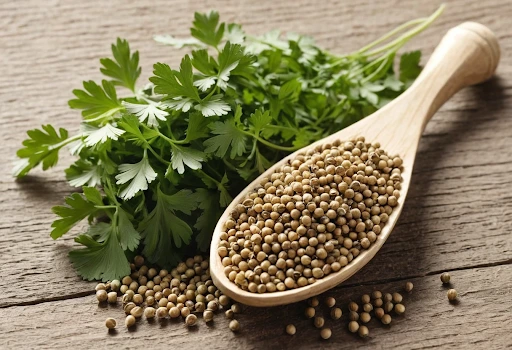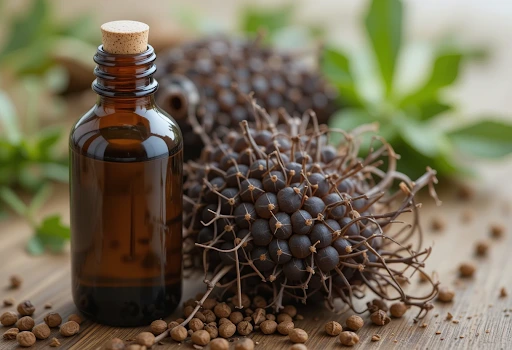Coriander Seeds and Cilantro Leaves
Coriander seeds contain an intense flavor packed in their little pods and are widely used to add subtle tanginess to soups, stews, marinades and Indian dishes such as garam masala. Coriander is also an integral component in many spice blends.
When purchasing coriander seeds, look for uniform seeds free from wrinkles and broken pieces that have an aroma that indicates freshness.
What is Coriander Seeds?
Coriandrum sativum plants are versatile herbs and spices used extensively across global cuisines, particularly Indian, Middle Eastern, Tex-Mex and South Asian dishes. Both their seeds (often known in America as coriander) and leaves (known in America as cilantro) offer incredible health benefits including being able to lower blood sugar, reduce inflammation and fight infections.
No matter their form, coriander seeds make a delicious addition to both sweet and savory recipes alike. Pickles, vegetable rubs and sauces all benefit from coriander’s distinctive nutty citrusy taste; while their inclusion as a key component in Indian curries (dhania jeera paste) makes a distinct statement.
Coriander has numerous culinary uses, from flavoring dishes to protecting against memory loss and increasing cognitive function in test-tube studies. Furthermore, its abundance of vitamin C supports white blood cell production as well as tissue healing processes. Furthermore, animal and test-tube research suggests coriander could even help lower blood pressure by acting as a diuretic and decreasing sodium intake.
Coriander Seeds vs. Cilantro Leaves
Cilantro is an aromatic fresh herb used to add zesty citrus flavor and vibrant green hue to many dishes, often used in soups and stews. As well as being high in Vitamin C and anti-inflammatory compounds, research suggests it can also help lower blood sugar levels while fighting infections; also it has heart, brain, skin, and digestive benefits; microgreens may provide an easier option if someone cannot tolerate the strong soapy aroma associated with mature cilantro leaves.
Coriander seeds, on the other hand, are small tan hued beads with ridges that can be toasted and crushed into coriander powder for use in Indian, Middle Eastern, Mexican cuisines as a key spice in curries, dals, biryanis and rubs and marinades.
Coriander seeds offer a refreshing floral taste when left whole, which pairs nicely with citrus and curry flavors. When ground, their roasted flavor emerges more strongly resembling cinnamon with its subtle nutty notes. As with all spices, preparation and ingredients used will determine their final flavor profile.
Coriander seeds or powder must be purchased fresh to produce optimal results. For best results, store in airtight containers away from heat and light for best storage conditions – up to three or four years should pass with proper storage conditions in place.
Coriander Seeds vs. Cilantro Powder
Coriander seeds and cilantro powder are different spices that should never be interchanged, and should only be used where their characteristics shine through. Cilantro leaves, with their strong citrus notes, make an excellent garnish or freshener for savory dishes while coriander seeds’ more earthy and complex profile pairs well with creamy or buttery dishes as a seasoning or topping; also suitable with meat such as chicken and lamb.
Infotoptrend: As a whole seed, sesame is both nutty and earthy with citrusy notes, perfect for crushing or lightly rubbing to release its flavors or grinding for a smoother taste and texture. Finely ground seeds can be added to curries, soups, sauces, and marinades or used as a spice rub for meat. They are also great for pickling vegetables before being ground finely. To enhance their flavors further, whole or gently cracked seeds can be dry-roasted before grinding finely!
When purchasing coriander seeds, look for those with an amber hue and dry and clean appearance – this indicates they were properly harvested and dried prior to storage; coriander can last up to one year when stored correctly.
Coriander Seeds vs. Cilantro Oil
Cilantro and coriander seeds both boast vibrant citrusy aromas that lend themselves well to culinary creations. Their seeds can be found in spice blends, thickening curries or being roasted to increase their flavor – as well as being used in drinks and essential oil production.
Seeds of all varieties can be purchased either whole dried seeds or ground. When choosing to purchase whole or ground varieties, opt for those in light brown or green colors rather than the more popular dark brown variety for fresher tasting seeds. If possible, toasting will increase flavor depth.
Coriander seed oil contains numerous beneficial constituents, such as aldehydes and linalool. Studies have demonstrated the latter’s antimicrobial activity against bacteria such as E coli and Staphylococcus aureus. Coriander seed oil may be applied directly onto skin as massage oil or used to soothe digestive or respiratory ailments – even being taken internally to stimulate digestion!
Both cilantro leaves and seeds contain an abundance of minerals such as calcium, iron and magnesium. Furthermore, both are great sources of vitamins A and C as well as providing significant amounts of antioxidants – perfect for smoothies, juices and salads while the seeds pair nicely with hearty stews or sauce-laden meat dishes!
Read also:Coriander Seeds and Cilantro Leaves (Coriander) Leaves




